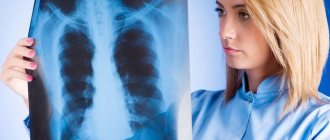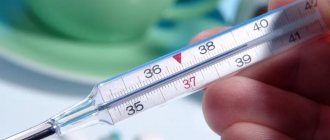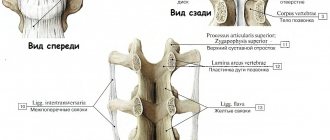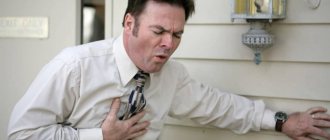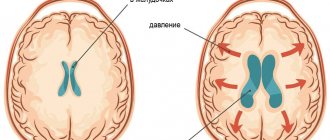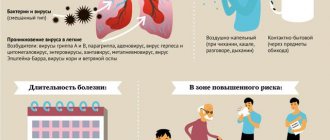Bacteria and viruses entering the human lungs by airborne droplets lead to pneumonia.
Once in favorable conditions, microorganisms begin to multiply in the nasopharynx and then reach the alveoli of the lung. When the amount of inhaled infection becomes significant or a person's immune defense is weakened, the lungs become infected. The rapid human immune response damages the lung tissue, which will lead to difficulty in oxygen transport. What types of pneumonia are there?
If a person gets pneumonia outside the hospital, then the pneumonia is called community-acquired.
Nosocomial pneumonia, on the contrary, develops in hospitals and nursing homes. This also includes pneumonia associated with mechanical ventilation.
Dividing the disease according to its origin helps to select the necessary antibiotics in the first hours of the disease.
The more areas of the lungs are affected by inflammation, the more dramatic the development of pneumonia. Depending on the location of the zones of inflammation, there are unilateral, bilateral, polysegmental, and lobar.
“Atypical” and “typical” pneumonia
Any pneumonia is dangerous if it is not detected in time and the correct treatment is not prescribed. The word “atypical” stuck after the emergence of SARS in 2003. This pneumonia required completely different treatment. In atypical pneumonia, complaints and symptoms may differ from classic pneumonia - not a high temperature, the symptoms are more similar to ARVI.
Typical pneumonia is caused by “classical” pathogens. These include Streptococcus pneumonia (pneumococcus), as well as Haemophilus influenza (hemophilus influenzae).
Non-classical microorganisms cause atypical pneumonia. For example, Legionella, Mycoplasma pneumoniae, Chlamydia pneumoniae, Chlamydia psittaci, Coxiella burnetiid.
Pneumonia caused by respiratory viruses are grouped separately - Influenza A, Influenza B, Rhinoviruses, Parainfluenza, Adenovirus, Respiratory syncytial virus, Metapneumovirus, Coronaviruses (SARS Cov-1, SARS Cov-2, MERS).
The differences between “atypical” and “typical” are relative. If you take an x-ray of the lungs, it is possible to assume an atypical pathogen based on the characteristics of the obtained x-ray.
Prevention of pneumonia
To avoid developing pneumonia, you should regularly follow these recommendations:
- observe the rules of personal hygiene - do not eat or touch your face and mouth with unwashed hands;
- Perform light physical activity every day, do exercises, or walk a lot in the open air;
- eat food enriched with fiber, vitamins and minerals (especially during an epidemic);
- rest regularly, avoid stress if possible, maintain a daily routine;
- ventilate the room several times a day;
- harden the body (just not during any illness);
- get rid of bad habits, especially smoking, as this bad habit increases the risk of developing pneumonia;
- during seasonal epidemics, it is necessary to avoid public places with large crowds of people;
- do not overcool or overheat the body;
- Get vaccinated if possible.
Timely contact with a competent specialist guarantees the absence of secondary diseases in the future. Pulmonologists at the Yusupov Hospital will ensure a quick recovery for the patient, protecting him as much as possible from the development of complications. You can see a doctor by first scheduling a consultation on our clinic’s website or by calling.
What determines the severity of pneumonia?
- Pneumonia may be limited to fever, cough with sputum without breathing problems. This is a mild form description.
- Severe course is manifested by respiratory disorders, multiple organ failure, and sepsis.
- A person's immune response determines the extent of lung damage. The more massive the response, the more severe the disease.
- Obesity, chronic heart and lung diseases, and diabetes worsen the prognosis of the disease.
Who gets pneumonia more often?
- The older a person is, the higher the risk of disease.
- Patients suffering from COPD, bronchiectasis, asthma, chronic heart disease (heart failure), stroke, diabetes.
- A previous viral infection (ARVI) provokes bacterial or fungal pneumonia.
- Smoking and excessive alcohol consumption contribute to the disease
- Other lifestyle factors - such as prisons, homeless shelters, exposure to environmental toxins (such as solvents, paints, or gasoline)
What the doctor may note
The most reliable diagnostic method is computed tomography. But we must not forget that the doctor cannot refer anyone infected to this procedure, because quite often the disease occurs without pneumonia. Therefore, the doctor himself decides on the need to conduct diagnostic studies. Changes in X-ray diagnostics, which are recorded during computed tomography, are divided into 4 degrees: at stage 1 of severity - single lesions, and at stage 4 - “minced lung”.
But we must not forget that the picture during instrumental studies does not always coincide with what the doctor sees and listens to from the patient. If the area of the lesions increases significantly within a couple of days, then the patient is diagnosed with a severe course of the disease. A characteristic symptom on an x-ray is “ground glass” syndrome, which appears due to a decrease in the airiness of the lung tissue.
Symptoms and signs of pneumonia
Complaints with pneumonia are sudden. Fever, chills, fatigue, chest pain combined with cough (with or without phlegm), shortness of breath, difficulty breathing, increased breathing occur and increase over several hours.
Blood tests will help diagnose the disease: leukocytosis or leukopenia is the result of the body's inflammatory response. Inflammatory markers such as ESR, C-reactive protein and procalcitonin may increase, although the latter is largely specific to bacterial infections.
A mandatory test for diagnosing pneumonia is chest x-ray.
Treatment at the Yusupov Hospital
If the diagnosis of pneumonia is confirmed, immediate treatment is necessary. Self-medication in this situation is not only unjustified, but also deadly. Qualified specialists at the Yusupov Hospital Therapy Clinic will select an effective and safe regimen for the body to take new generation drugs and provide comprehensive support until recovery.
In the 24-hour inpatient Yusupov Hospital, you will find a comfortable stay in cozy rooms, nutritious meals and high-quality medical care from attentive staff.
Don’t risk your health; at the first sign of pneumonia, make an appointment with a specialist at the Yusupov Hospital Therapy Clinic by phone. The nuances of hospitalization can be clarified on our website by contacting the coordinating doctor online.
Make an appointment
Pneumonia due to COVID 19 infection.
The course of the disease does not go beyond the general concept of pneumonia. Classic symptoms are present: fever, chills, muscle pain, cough.
80% suffer from pneumonia without breathing problems and at home.
20% have severe manifestations of the disease: breathing is difficult, the person begins to breathe quickly, and there is a need to use additional oxygen. If it worsens, failure of important organs such as the heart and kidneys may occur. The longer the patient is in the hospital, the greater the likelihood of hospital infections and fungi.
Is hospitalization necessary for COVID 19 pneumonia?
No, hospital treatment is not always required.
Outpatient treatment is possible for patients with mild pneumonia. Patients who are initially healthy, with normal breathing, and without concomitant diseases are treated at home.
Hospitalization is necessary for patients whose oxygen saturation is less than 94% and who are breathing rapidly.
I feel like I'm having trouble breathing. Am I having respiratory failure?
The easiest way to understand that you are developing respiratory failure is to count your “inhalation and exhalation” per minute. If more than 21, then you should call a doctor. Another way is to measure the oxygen in your blood. Many people already have a pulse oximeter at home. With this device you can monitor saturation - if it is below 94%, then regard this situation as a deterioration and seek help from doctors.
Forecast
The prognosis of the disease will depend on the patient’s age, the resistance of the pathogen, the presence of additional diseases, the reaction of the immune system and the correct choice of therapy. Bilateral pneumonia will have an unfavorable prognosis in the case of a complicated course of the disease, the presence of immunodeficiency conditions, and in children of the first year of life.
With timely and adequate treatment, bilateral pneumonia ends in recovery. Complete restoration of lung tissue structures is observed in 70% of cases.
The use of CT in the diagnosis of viral pneumonia.
Computed tomography has high sensitivity compared to radiography and detects changes in the lungs at the initial stages of the disease earlier than the results of laboratory tests.
- The advantage of the method is that it detects changes in the lungs even in people infected with COVID-19, but who have no symptoms of infection.
- Despite its high sensitivity, CT cannot give an accurate answer about the causes of pneumonia (bacteria, viruses, fungi).
What is “ground glass” in a CT scan?
Densification of the lung tissue “frosted glass” is the initial phase of pneumonia. Occurs when the alveoli gradually fill with fluid.
When the bronchi and alveoli fill with fluid, areas of compaction will appear, which are called consolidation. Consolidation of lung tissue occurs during a prolonged inflammatory process.
I have COVID 19 and CT-2 What does this mean?
It is important to understand how much lung tissue is affected. The more the lung tissue is involved in inflammation, the more difficult it is to obtain oxygen from the inhaled air. Without oxygen, a person quickly dies. For example, with pneumonia caused by COVID 19, it takes several hours for the lungs to worsen. The sooner a decision is made about hospitalization, oxygen therapy and treatment, the greater the chance of recovery.
To assess changes, the percentage of lungs damaged by pneumonia is calculated. The measurement is carried out “by eye”. The obtained result is compared with the scale of prevalence of changes:
- CT-0 – no signs of pneumonia
- KT-1 – up to 25%
- KT-2 – from 25 to 50%
- KT-3 – from 50 to 75%
- KT-4 – over 75%
The percentage score sorts patients who urgently require hospital treatment from those who can be treated at home.
If your CT scan is 2, this corresponds to mild pneumonia. Such changes are not accompanied by difficulty breathing and do not require hospitalization. But CT 2 can, if treated incorrectly, turn into CT 3 and 4. Therefore, supervision by a doctor is mandatory!
If the doctor does not hear wheezing in the lungs when listening, does that mean I do not have pneumonia?
This is not true. Diagnosis requires demonstration of changes in lung tissue on radiography (CT) and clinical manifestations (eg, fever, shortness of breath, cough and sputum production), changes in blood tests.
General and specific clinical manifestations of pneumonia without fever
Among other things, both general and specific local signs make it possible to identify pneumonia in a sick person without fever:
- Sputum production.
- Hard breath.
- Pain in the lungs when inhaling and exhaling.
- Chest asymmetry.
These signs of pneumonia without fever should be the reason for immediate consultation with a specialist.
Latent pneumonia may not be accompanied by fever and cough when the patient has already completed the course of treatment in a hospital facility. In such situations, it is recommended to contact again.
Treatment of pneumonia
To treat pneumonia, you need to know the name of the infection. In patients, the name of the pathogen is unknown at the very beginning of the disease, so empirical antibiotic therapy is used - treatment aimed at the likely pathogen. For all patients with CAP, treatment regimens have been developed aimed at destroying S.pneumoniae and atypical pathogens.
For most patients, combination therapy with beta-lactam antibiotics or macrolides is used. Alternative regimens include fluoroquinolone monotherapy.
Treatment of SARS CoV-2
- The principles of treating pneumonia are general. Prescription of antiviral and antibacterial therapy.
- In severe cases, in a hospital setting, high-flow oxygen therapy, monoclonal antibodies, anticoagulants, and pulmonary ventilation are prescribed.
- Antibiotics do not work against the COVID 19 virus.
Prognosis and prevention
The best treatment for pneumonia is prevention. Vaccines are available for children from two months of age. It is important to take care of the diet of a patient with pneumonia. During treatment, rest, bed rest and plenty of fluids are recommended to prevent dehydration of the baby's body after the formation of a large amount of mucus and due to increased sweating.
Typically, at the onset of the disease, children experience loss of appetite, but as they recover, it returns to normal. A healthy and nutritious diet is recommended to avoid nutritional deficiencies that can lead to other disorders in the body.
It is necessary to control the environment in which the patient is located, whether in a medical facility or at home. Avoid the presence of smoke (such as tobacco) or other lung irritants that may aggravate the condition.
After discharge from the hospital, children require clinical observation and rehabilitation measures. It is also recommended to strictly follow the doctor’s recommendations after recovery, correct daily routine, and moderate intake of vitamins as a preventive measure. Dosed physical activity contributes to the overall recovery of children and can prevent recurrence of pneumonia.
Rehabilitation after pneumonia
In addition to drug therapy aimed at bacteria, virus and inflammation, it is necessary to restore lung function to its original healthy level.
After an illness, changes form in the lungs. This includes “frosted glass” and fibrosis of the lung tissue, pneumofibrosis. In these areas, gas exchange is difficult, the nutrition of the alveoli and bronchi is disrupted, and the protection of the bronchi is reduced. Infection and pneumonia affect a person at the same time, depriving him of strength, confidence, and reducing the quality of life. Efforts must be made to prevent fibrotic changes in the lungs. The problem is solved by a rehabilitation program consisting of a set of medical procedures, inhalations, breathing simulators, and physical therapy exercises.
More about rehabilitation
Breathing exercises
To prevent pneumonia
Today, the prevention of pneumonia is one of the most important in the complex of health practices and care for the condition of the human body. It has become obvious that lung damage is a real threat, much more widespread and urgent than it seemed to many of us just recently. The coronavirus pandemic has made adjustments not only to our way of life, but has also made it extremely important to take care of our respiratory system and its healthy and complete state.
One of the most effective ways to prevent pneumonia is regular breathing training with the Samozdrav simulator. And there are justified reasons for this and many years of indisputable evidence.
Breathing exercises strengthen the respiratory muscles, which increases the mobility of the chest and diaphragm. Effective movements of the respiratory muscles increase the volume of the chest and lungs. This ensures maximum pulmonary ventilation and air circulation in the alveoli and increases the utilization rate of oxygen in the lungs and its delivery to the tissues.
Maintaining normal lung volumes and regular training of the respiratory muscles forms the correct respiratory rhythm. As a result of this, the respiratory rate, its minute volume and other indicators that are disturbed due to stress, physical inactivity, and chronic diseases are normalized. Physiologically correct breathing is maintained for a long time.
Breathing exercises maintain the elasticity of the lung tissue. This increases the vital capacity of the lungs and prevents the development of fibrosis and other changes in the lung tissue. CO2 eliminates bronchospasm, which also increases breathing efficiency.
Breathing training increases the efficiency of the pulmonary circulation. This is especially important for older people, because one of the common causes of pneumonia in the elderly is stagnation of blood in the small circle.
As a result of restoration of the functions of the respiratory system and blood circulation, the inflammatory process is reduced, congestion in the bronchi and lungs is prevented, and mucus and exudate are reabsorbed.
In addition, Samozdrav compensates for the lack of physical activity, and breathing training, like physical exercise, promotes the production of a natural antioxidant (superoxide dismutase), which prevents the development of pneumonia.
All these arguments are the result of numerous in-depth studies related to the study of the effect of breathing training with Samozdrav on human lungs and the prevention of pneumonia, as well as the experience of people of different ages and different levels of health.
Today, millions of people from around the world train with Samozdrav to prevent the development of pneumonia - one of the main dangers to the body during a pandemic.
If you want to get one of the most effective ways to take care of your respiratory system, an indispensable assistant for the prevention of pneumonia, purchase the Samozdrav breathing simulator. Years of experience have proven its effectiveness, accessibility and the highest results in maintaining lung health.
For rehabilitation after pneumonia
During a difficult period of threats of a high viral load on the body, it is important to know how to quickly get back into shape after pneumonia and allow your lungs to work at full strength again. Firstly, it is important to follow the general rules of caring for yourself and your health. Sleep at least 8 hours at night and a couple of hours during the day, eat well, not forgetting vitamins A, B, C and calcium, ventilate the room every three hours.
Particular attention should be paid to your lungs, devoting time to breathing exercises to improve pulmonary circulation and strengthen the pulmonary muscles. Through breathing training with the Samozdrav simulator, exudate will be absorbed, sputum separation will be facilitated, the airways will be cleared, lung tissue will remain healthy and elastic, tissue metabolism will be normalized and intoxication that accompanies the acute stage of the disease will be eliminated. Healthy breathing and normal inspiratory volume will be restored, shortness of breath will go away due to the normalization of oxygen levels in the body,
In the process of breathing training with the Samozdrav simulator, rehabilitation after pneumonia will be successful, it will be quick and comfortable, and you will be able to regain your vital energy in a natural way - by training through correct and healthy breathing.
Our specialists
Chikina Svetlana Yurievna
Candidate of Medical Sciences, pulmonologist of the highest category. Official doctor, expert at Russian congresses on pulmonology.
30 years of experience
Kuleshov Andrey Vladimirovich
Chief physician, candidate of medical sciences, pulmonologist, somnologist, member of the European Respiratory Society (ERS).
Experience 26 years
Meshcheryakova Natalya Nikolaevna
Candidate of Medical Sciences, pulmonologist of the highest category, associate professor of the Department of Pulmonology named after. N.I. Pirogov.
Experience 26 years
Nikitina Natalia Vladimirovna
Deputy chief physician, pulmonologist, allergist of the highest category. Full member of the European Academy of Allergy and Immunology.
Experience 15 years

